My 2021 Buck – Part Two
THE ACTION STARTS
In Part One, I wrote about the setting for my 2021 season, addressing the opportunities and the challenges. To recap, the biggest opportunity was a buck I felt I knew from the season before. The challenge was the layout of the farm itself. It is really hard to hunt that property without spooking and educating deer. With that backdrop, I began hunting the buck on October 25.
OCTOBER 26 – SIGHTING THE 6 X 5
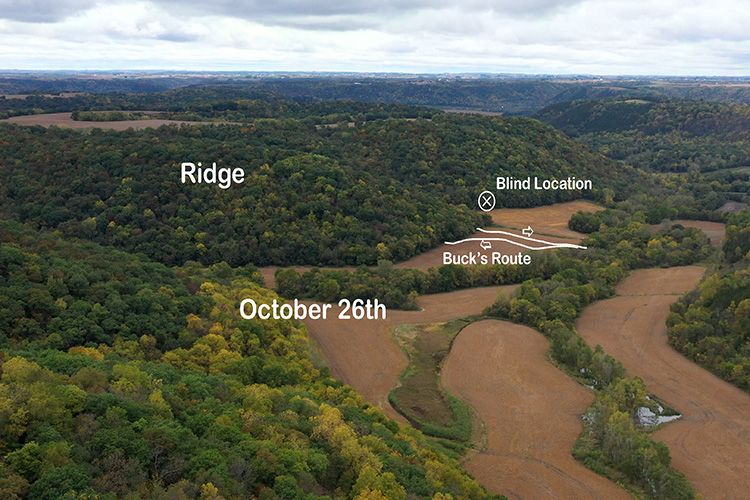
I first sighted the buck I was hunting on October 26. I was sitting in a Redneck Blind as shown in the photo and the buck came off the ridge, crossed the bottom cornfield to the creek bottom and then after about 20 minutes came running back out. The sighting confirmed that the buck was still alive and living in the same place where he lived the fall before.
My first adrenaline rush came on the afternoon of October 26 when I sighted my target crossing the cornfield about 150 yards away. It was the first I had seen him since the previous November (remember, I didn’t have any trail cameras out in 2021) and he looked very good.
I spotted him coming off the long ridge where I guessed he was living. He crossed the cornfield into the creek bottom cover beyond.
He had no interest in my grunt call. After about 20 minutes, something must have spooked him because he came running out of the creek and back to the ridge.
So, I now had confirmation that he was still alive and that he was, indeed, still living on the long ridge. After sleeping in the blind, I had high hopes of seeing him the next morning, but I gave up about three hours after daylight having seen only two small bucks.
I spent the next couple of hours moving one of my blinds into bow range of the spot where the buck entered the creek bottom – just in case that was part of his routine.
I knew my best chance for killing him with a bow would be on the ridge itself where I could create a much closer encounter than was likely on those big bottom fields. I had to come up with a good plan to hunt up on the ridge without blowing the deer out.
Going into the season, I had figured this might be a problem and had bought a warm (-20 degree) sleeping bag and waterproof nylon bivvy sack so I could sleep not only in my blinds, but also on the ridge near my stands. I really didn’t have any options. If I was going to hunt that ridge I was going to spook a lot of deer coming and going unless I slept up there.
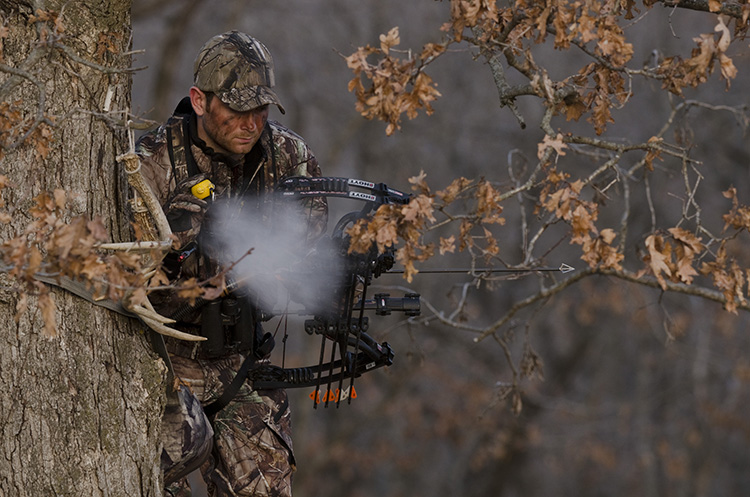
When setting up on ridges, hunt the downwind side, but be sure you aren’t too far over the side. If your stand height is below the top of the ridge, you will have swirling near your stand.
HUNTING RIDGES
There are usually several trails along the slopes on either side of a ridgetop, but you should focus on the ones near the top – on the downwind side.
That is where the deer tend to walk and where your scent will be easiest to control. I like to set up about 40 to 50 yards from the top of the ridge so I can cover a couple of the trails above me and usually one down the slope.
As long as your actual stand is on a level with the top of the ridge (or above), the wind will be fairly stable and that should carry your scent over the heads of deer below (downwind).
If you place your stand too far down over the side of the slope, however, the ridge will block the flow past you and the wind will swirl downward as it blows by your stand. This is especially true when the wind gusts. If you are blocked by the ridge top, your scent will swirl down.
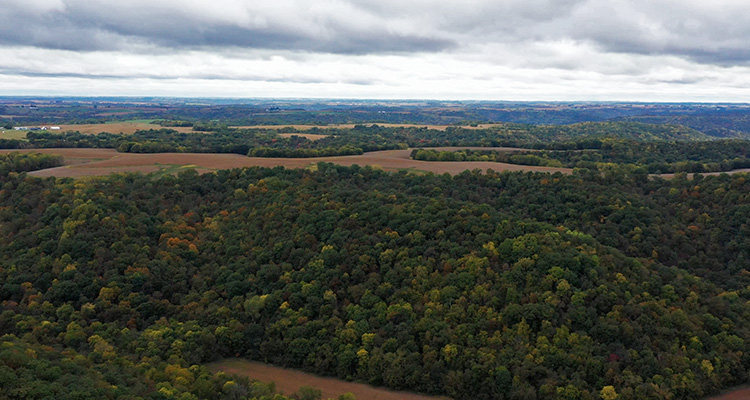
Right in the center of the photo is the ridge I was hunting. You can see a big field on top that is not on the farm I can hunt, and you can see the edge of the field below in the bottom where I can hunt. A normal pattern in country like this has the deer bedding on the ridges and then either dropping down to the bottom fields, or following the ridge out to the top fields to feed in the evenings.
OCTOBER 29, 2021
Waiting for a north wind, I made my first hunt on the ridge on October 29. Using the ditch for cover, I snuck up the steep south facing slope to the same area where I had passed the buck the season before.
This is a spot close to where the secondary ridge I was hunting comes off the primary ridge that was covered in a massive corn field. In other words, it is about as far from the end of the ridge as I could get on the property I had access to hunt. I was about forty yards from the property line.
So, to create this picture for you – there is picked corn below on the bottom fields where I can hunt and there is picked corn out on the big wide part of the ridge complex father to the west that I can’t hunt.

This is the layout for my hunting spot on October 29. With a north or northwest wind I knew I needed to be on the south side of the ridge top. I set up my camp about 30 yards below (downwind) of my tree stand site.
My choice of stand sites was important for two reasons. The deer generally bed most heavily out toward the end of ridges; by hunting as far from the point as possible, I was cutting off the largest number of deer that headed along the ridge toward the big ag field on top.
Second, this spot kept me from bumping into a lot of deer when going in and setting up.
Further, I planned to sleep on the ridge rather than risk alarming and educating a bunch of deer by walking out after dark.

This is my camp about 30 yards from the tree I eventually selected for my stand. It is down the hill and downwind of my stand. By sleeping here, instead of going all the way back to the vehicle after dark, I greatly reduced the number of deer I educated. At night, I put all my clothes inside the rubber bag to keep them from getting wet and to contain odors.
I stopped about 70 yards from the top of the ridge and found a place to set up my “camp”. I had packed the bivvy sack, sleeping pad and warm sleeping bag inside a rubber canoe bag and strapped my stand to the bag.
I tied a rope around my outerwear and attached that to the bag too. I carried my tree steps, folding saw, pull up rope and safety line in a fanny pack around my waist. I am guessing my total kit weighed about 45 to 50 pounds!
I planned to put all my clothes in the rubber canoe bag at night to keep everything dry from dew, or brief rains, and to keep the deer from smelling them. It was all I needed for a couple days of fun!
It doesn’t take long to set up that simple camp, just inflate the pad and slide it and the sleeping bag into the bivvy sack and cover everything with leaves and sticks.
I selected a spot against a tree trunk about 30 yards down the slope from where I expected to place my stand. This would keep my camp downwind and out of sight from the deer using the sidehill trails closer to the top of the ridge.
The tree trunk also served the important role of keeping my “camp” from sliding down the hill on the wet leaves during the night!
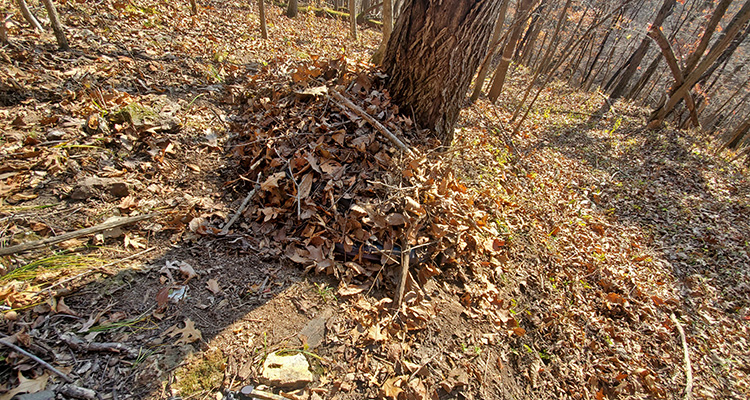
I covered my camp with sticks and leaves before heading up the slope to place my stand. It was completely invisible from even a short distance away. I had deer walk within five yards and not notice it.
I should be writing that I killed the buck that afternoon, but I didn’t. I screwed up. It had rained earlier in the day and the leaves were wet and silent underfoot. While this helped me to sneak in undetected, it also allowed the deer to sneak in undetected, as well.
I was set up by noon, seeing bucks cruising immediately. It was by far the best afternoon of hunting I had all season. About three hours before the end of legal shooting time I was just sitting there staring up the slope toward the top of the ridge when I heard a loud snort right behind my stand.
I knew immediately that it was a buck from the deep tone. I whipped my head around just in time to see him running away – the buck I was hunting had been five yards away on the trail behind my stand and I didn’t even know he was there! Man, I felt sick. I almost cried!

You have to stay alert during the rut. A buck can approach from any direction at any time. I messed up and got lazy and the buck I was hunting snuck in to five yards behind me on the wet leaves and smelled me.
But he wasn’t super spooked. He must not have seen me and had only caught a whiff of me because he stopped at 45 yards and took a few steps back, trying to figure out what had happened.
I attached my release to the string just as he turned and bounded off in the direction from which he had come – the opposite direction, by the way, from where I had expected to see him.
That was sighting number two and I was totally disgusted with myself. I had gotten lazy and had not been scanning my surroundings like you have to during the rut. The fact that he came from the “wrong” direction is no excuse. I should have seen him coming.
But, if I had shot him then, I would not have had the adventure that followed and I would not have learned as much about deer and how to hunt them as I did during the next two weeks.
Though I was afraid I had muffed my one big chance for this buck, I still felt the ridge was the best place to find him and I didn’t think that I had spooked him too badly. I considered moving the stand but decided to leave it where it was.
FIGHTING DOUBT
I kept hunting the ridge whenever the wind was strong enough to cover the sound and movement of my midday approach. I always went in late in the morning and snuck very slowly up the slope using the terrain to help hide me. I would glass ahead every few yards looking for bedded deer. I found that I could sneak by them surprisingly well as long as I moved slowly.
Each time I made the trip up the ridge, I would sleep on the ground near my stand. On the days when the wind was too still to sneak onto the ridge unnoticed, I hunted the Redneck Blinds in the field below and slept in those to keep from bumping deer coming and going.
Though I had my truck rigged up for sleeping – I did this before heading to British Columbia in early September – I never got to use it because I never slept anywhere but in the field (or occasionally at my parents house). I believe mom and dad thought I was crazy – and after a couple of weeks, I was starting to believe it too.
Though I hunted carefully, I didn’t see the buck again until a week later, on November 4th. Put that in perspective. People think, “I will just go to Iowa and find a giant behind every bush.” I hunted hard for a solid week on a good farm and didn’t see a single shooter, let alone the buck I was after. Had that been my entire vacation, I might have had a much different view of Iowa after it was over!
But, fortunately, that wasn’t my entire vacation. I had the whole season. That is not to say that you don’t get discouraged even when you have time on your side. You start wondering and doubting. To keep hunting smart and not start to get sloppy, you have to believe that your whole season can change at any moment. Sometimes you have to take a little break to reset the batteries. I did that occasionally by going into town to visit my parents and join them for a meal.
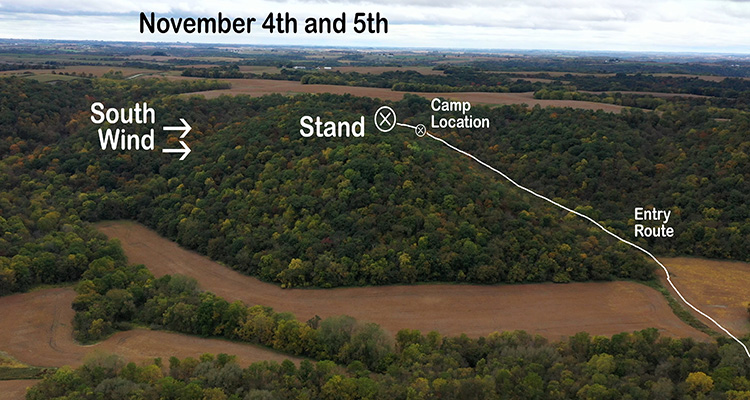
This is where I was hunting on November 4 and 5. The wind was from the south so I needed to be on the north side of the ridge. The buck showed up both times to my left as I looked up the slope (farther out on the ridge where most of the deer tend to bed.)
NOVEMBER 4TH AND 5TH
Late in the morning on November 4th, I grabbed my camp, a tree stand and a small bit of food and water and started sneaking up the ditch – this time on the north side of the ridge. The wind was forecast to be from the south for several days so I knew I had to be on the north side.
I can’t remember every deer I saw that day, there were a handful of smaller bucks and a couple of does, but I do remember the 6 X 5 showed up to my left (farther out on the ridge) about an hour before the end of legal shooting time.
He started heading slowly along the ridge from left to right – toward the big ag fields on the primary ridge. This was the pattern I expected, but I had hoped he would travel one of the trails down over the side of the ridge. Instead, he stayed close to the top and worked his way slowly along, eating acorns.
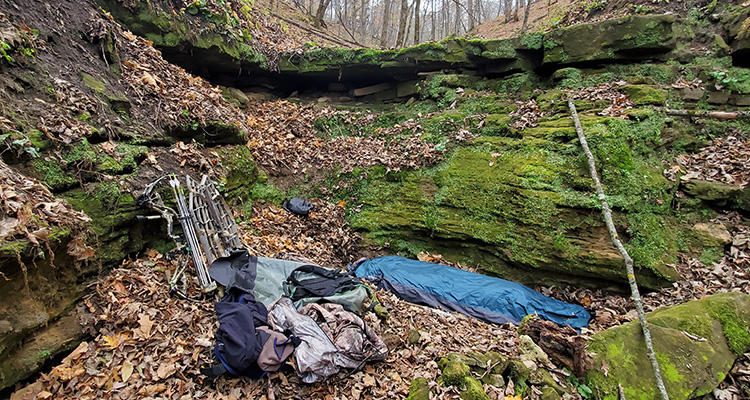
My coolest camp was the one I used in the ditch on the north side of the ridge. It would have been a fun place to actually camp – with a little fire and hot dogs, etc. But I only set it up and took it down during the day – the rest of the time I was only there during the dark and then I was trying to be as quiet and nonintrusive as possible. It was a very comfortable place to sleep on those windy nights and would have been perfect if not for a few pack rats that visited from their home in the rocks above.
At his closest, the buck passed at about 65 yards. I let him get by me so he wouldn’t be able to pinpoint the sound as easily and then I grunted to him. The buck was about 75 yards away at that point, too close really to call to, but I was desperate.
He stopped, looked and took a few steps my way before deciding there was no other buck nearby. He then resumed his slow trek, stopping often to eat acorns.
I was excited to see him and felt that I would be in the game the next morning. I stayed in the stand until well past dark just to make sure he was long gone. Then, as quietly as possible, I climbed down and dropped into the ditch below where my sleeping bag and a couple beef sticks awaited.
It was a really cool spot for my camp but I did get two visits during the night from what I am guessing were pack rats living in the rocky ledge above me.
I was up early and as quietly as possible got dressed and covered my camp with sticks and leaves so no passing deer would to see it. By daylight, I was in my stand, filled with hope.
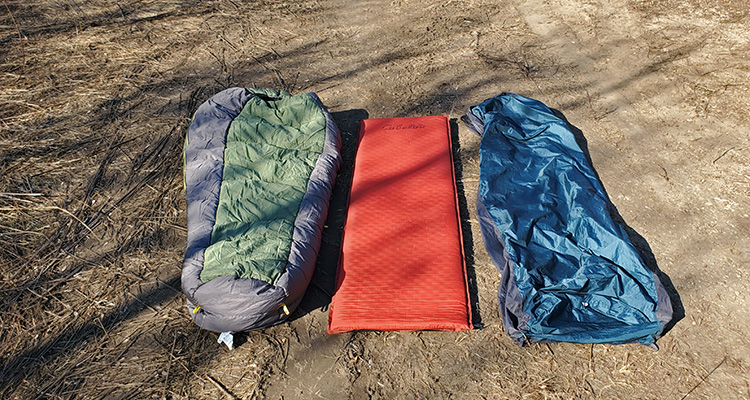
This is the “camp” that I carried with me on all my hunts on the ridge. It is comprised of a warm sleeping bag (this one rated for -20 degrees) an insulated pad and a waterproof nylon bivvy sack. The pad and sleeping bag go into the bivvy sack for dry, comfortable sleeping. I carried these items in a rubber canoe bag that I also used to hold my clothes at night when I was sleeping.
I expected the buck to come from the direction he had gone the night before (from my right), so I was surprised to see him shortly after daybreak already up on the ridge, well out toward the point to my left. He had looped around me during the night. I tossed out a few grunts, but he just looked and ignored me in favor of eating acorns.
I figured for sure he would be cruising, but he was just hanging out. Maybe there was a doe bedded nearby, because after about 30 minutes of eating acorns he slowly eased his way farther out on the ridge and out of sight. I assume he bedded there.
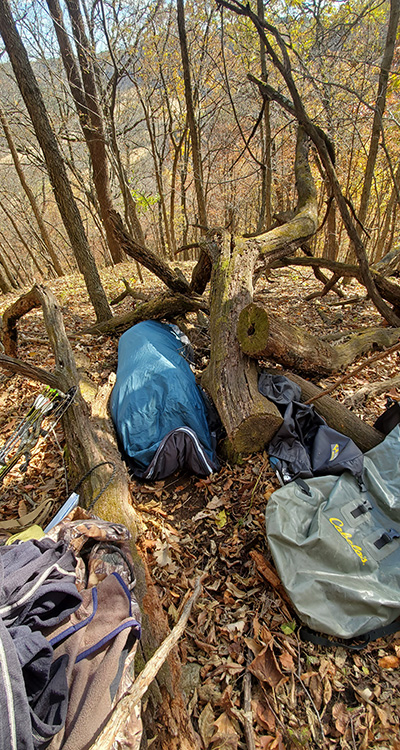
During the week that followed my third and fourth sightings, I hunted the next ridge to the north a few times, thinking that maybe the buck had moved. This camp was one of my favorites, nestled in a tree top just 10 yards from stand. It worked perfectly. Once covered with sticks and leaves, the deer paid it no attention.
I was pumped, guessing he would come my way sometime during the day. I never left the stand, watching intently as the hours went by with no more sightings of the big deer. A few other bucks cruised the trails within easy bow range of my stand, so I had high hopes he would do the same during the final hour.
The day ended in disappointment as the buck never showed up. He obviously went out a different way, maybe to the fields below. At dark, I climbed down and headed back to my camp in the ditch.
The next day was uninspiring. I saw very little movement and was freezing and worn out (from lack of food and water probably) and ready to leave by late morning. I climbed to the ground, gathered my camp and headed back down the ditch to my four wheeler and then to my truck where I grabbed a couple sandwiches, some much needed water and started to make my afternoon plan.
THE REST OF THE WEEK
The next several days were a combination of overnights in Redneck Blinds in the bottom fields surrounding the ridge and overnights on the ridge itself.
I also started hunting the next ridge to the north, only about 300 yards from the buck’s core area. That’s where he was headed when I saw him on November 4th. Maybe he was covering more ground or had moved. I needed to spread out a bit just in case.
I was tempted at a point to put up a new stand farther out on the ridge where he was living, closer to where I guessed most of the deer were bedding, but decided not to press things. I knew my two stands (one for north wind and one for south wind) were the most conservative. I just needed to put in time and hope for luck.
In Part Three of this story, I will get to the day when I actually shot the buck: November 12.

Interesting to learn some of these tactics to pursue one buck. In my little experience bowhunting (5yrs) I’m definitely learning about patience trying to kill a monster buck for my standards that has suddenly vanished it seems.
Alex, it does take a bit different commitment to hunt just one deer, but it is rewarding when it pays off. But don’t get me wrong on this one. I was hunting him because he was the only good buck on the farm that I knew of. If a different good buck had wandered past, I definitely would have shot him instead.
I’m really liking these Uncle Bill. Thanks for sharing. Will look forward to you telling your story on MW or Huntr podcast!
Josh, thanks. I did go on the MW podcast and talk about the hunt. Here is the link to that podcast: https://www.youtube.com/watch?v=cwDhAXfx1Vw&t=60s
I appreciate your support and will plan to keep the content coming here on this site. Hope you have a Merry Christmas.
I was so glad to come across this blog as I read your story in Peterson’s Bowhunting a month or so ago and thought it was fascinating and wanted to find out more about it and so this series of blogs absolutely fulfills what I was hoping to find. I have some questions for you and I would characterize myself as approximately your age and I’ve been bowhunting for a long time. Anyway, here are my questions: 1. You based your stand location on the predominate wind and set up on the downwind side of each ridge accordingly. That makes sense but what about thermals? I hunt hilly terrain in WNY and If I just went with the predominate wind, I would worry about my thermals rising up to the buck even though the predominate winds are blowing the riight way. Did you account for those thermals in any way? Why were they not much of a concern? 2. Did you use two different portable stands on this ridge, one for the N-NW winds on the southern side of the main ridge and the other on the North side when you had S-SW winds? Or did you just attach your sticks and stand whenever you hunted each location? I ask because I would just use a saddle and a one stick in these circumstances. Much lighter and you always have it with you to set up in different locations if you determine that would be a good course of action. Thanks for these kinds of articles these really pique my interest the most. Big buck strategy strategy in hill country.
Vince, thanks for finding me here. Going through your questions: 1. Unless it is nearly mountainous, the day winds (those on the forecast) will overpower the thermals. The farm I was hunting had elevation changes from ridge top to valley floor of about 400 to 450 feet. That is not enough to produce a thermal breeze on any but still days. In other words, the thermals caused by those elevation changes are overpowered by the 10 mph wind from the south (or wherever). In terrain like this (and that found in much of the Midwest) you get a thermal drift and not a thermal wind. I never consider thermals unless the day winds are forecast to be really low (5 mph or less) which is quite rare. 2. Yes, I had stands on both sides of the ridge so I could hunt it on either wind. I have not started hunting from saddles yet. I tried them about 30 years ago (they have been around for a long time) but liked the fixed position stands better. Maybe the saddle hunting has evolved enough to make them a good option for me now.
Thanks for answering my questions. As far as saddlehunting, yes they have been around for years. My cousin and I hunted out of an Advantage Archery saddle made in Belmont, NY back in the early to mid 1980’s but climbing stick technology was minimal or non existent and some climbing treestand manufacturer’s were really starting to make some stable and relatively quiet offerings so we naturally gravitated to them thinking we had everything on our backs to climb and stand. Which is a fine strategy until you want to climb a limbed tree!!!
Yes, or a crooked tree. I have placed stands in a ton of crooked trees in my life. Have a great day.